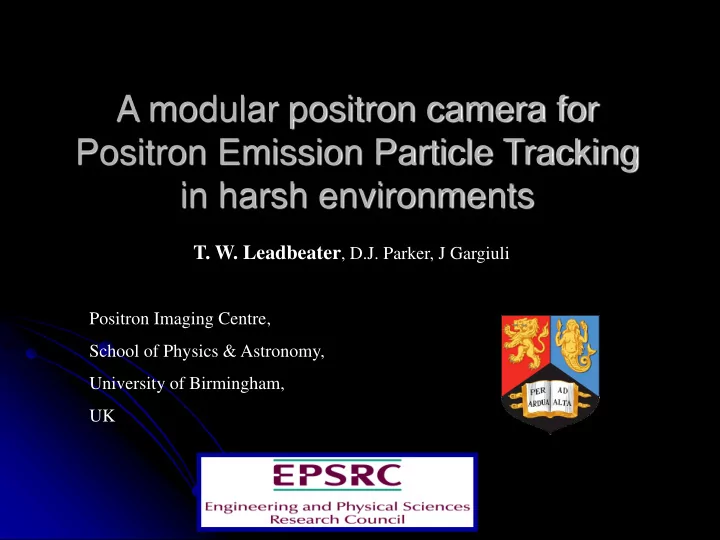

A modular positron camera for Positron Emission Particle Tracking in harsh environments T. W. Leadbeater , D.J. Parker, J Gargiuli Positron Imaging Centre, School of Physics & Astronomy, University of Birmingham, UK
Positron Imaging Positrons produced from b + decay of proton rich nuclei Positron loses energy & annihilates Results in 2 back-to-back 511 keV photons Coincident detection of both photons defines trajectory Medical imaging involves radio-labelling of glucose molecules Industrial imaging involves labelling fluids or particles
Positron Emission Tomography Comparison of MRI & PET images Acquisition times: Minutes – hours ~ 10 9 events
Positron Emission Particle Tracking Single particle loaded with radioisotope Line of Response (LOR) defined along photon trajectory Triangulation of successive LORs gives particle location 50 – 1000 events per location ~50% of 511 keV photons are transmitted through 11 mm steel Spouted fluidised bed, 7 mm thick steel walls
Particulate Science & Technology Three primary phases of matter: Solids, Liquids & Gases Particles / powders make up to 70% of matter processed by humanity: Solid particles, bubbles, liquid drops Particles / powders exhibit properties of all three phases: Withstand deformation (solids) Flow (liquids) Can be compressed (gases) Particulate science aims to understand relationships between micro- (particle scale) and macro- (bulk behaviour) properties Understanding of particle – particle and particle – fluid interactions
Detector Systems Detectors derived from redundant clinical imaging systems (ECAT-931 Siemens medical systems) 2 rings of 64 detector blocks: 8 x 4 BGO crystal elements 6.25 x 12.5 mm 2 4096 detection elements Modified for PEPT: Time information List – mode data storage
Modular Positron Camera Modular detector units (scintillators, PMTs, support electronics etc.) Central coincidence processing units Data acquisition and processing system Customisable geometry: Accommodate large apparatus Transportable Adjustable field of view: Design camera geometry for application High sensitivity regions-of-interest Cover many sections of device 16 modules housed in sturdy boxes and PAT tested
System Performance – Single gammas Energy resolution @ 511keV (FWHM photopeak) measured to be 15% (75keV) Energy discriminators set to 350 - 850 keV Accepts scatters up to 55 degrees, but allows high event rate Intrinsic peak efficiency measured to be 45% Response linear with activity up to 500k events per second Event rate saturation at 1M events per second Dead time 0.65 m s per module, 1.2 m s per block
System Performance – Coincidences 2 opposing modules separated by 250 mm Bare tracer peak coincidence sensitivity 5% (centre) Average sensitivity across FoV 1% Monte Carlo sensitivity maps used to optimise camera geometry PEPT algorithm relatively insensitive to non-uniform field of view
Practical Demonstration
In practice Data rates up to 4MHz ( optimum activity ~ 100MBq ) Locations on kHz basis Precision around 1mm in 3D Tracer moving at 1m/s moves 2mm in this time Transmission of 511keV photons allows real systems to be studied – i.e. dense and opaque systems, steel HVL 11mm Tracers with a size range 50 m m – mm’s Range of materials: Glass, sand, resins, catalysts, FCC and Gamma alumina, zirconia, drugs, plant seeds, potatoes, salt, coffee …
Fluidised bed: Chemical Engineering High pressure fluidised bed Used for polymer processing 7 bar pressure, 100C
Metal casting: Metallurgy & Materials Low temperature metals (100C) Aluminium (660C) Steel (2000C) Tracer particle activity 5 – 40 MBq Raw data rates 25-300 kHz Particle location rate 1 - 4 kHz. Locations accurate to: 0.5mm (stationary) 2.5mm (moving 1ms -1 )
Conclusions A modular positron camera has been developed allowing the study of a wide range of industrial systems The flexible geometry offered by the modular camera allows: The field of view of the camera to be custom designed Transportation of the camera to study applications in situ . Modular camera has been characterised Modular camera systems used for a number of experiments: Various locations both on and off Birmingham campus Recorded data at rates up to 4 MHz Frequent and accurate locations
Thanks for your attention Positron Imaging Centre, School of Physics & Astronomy, University of Birmingham, UK T. Leadbeater; t.leadbeater@bham.ac.uk D. J. Parker, J. Gargiuli, A. Ingram, S. Bakalis, M Barigou, J Seville.
Events Real events Random coincidences Scattered gamma rays Associated gamma rays
Recommend
More recommend